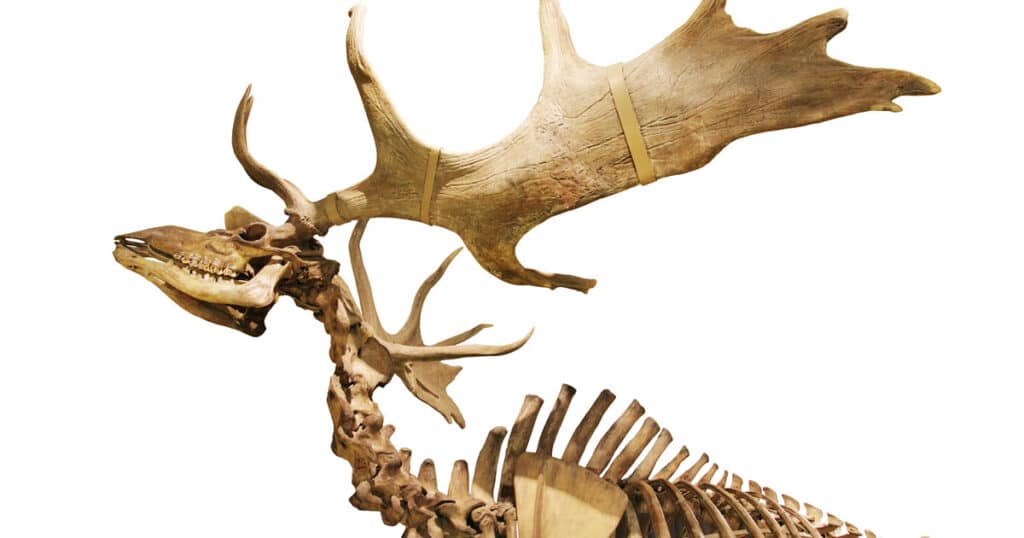Like humans, deer have bones and a skeletal system. Many of their bones are similar to human bones, but there are some key differences. And since there are hundreds of species of deer in the world, there is a huge diversity of deer anatomy. Let’s learn about the deer bones & skeletal system here.
Locating the perfect spot on a deer for a kill shot is essential for ethical hunting. In this article, we’ll go over the basics of a deer’s skeletal system and give you other useful information about deer anatomy.
How Many Bones Does a Deer Have?
The deer’s body has more than three hundred bones. To be precise, an average adult deer has 327 bones. Like humans, a deer’s skeletal system develops over time.
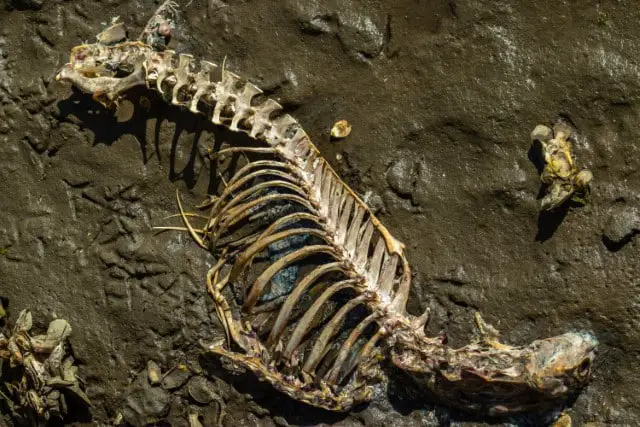
For comparison, deer have more bones than humans, horses, and dogs. Humans have 206, horses have 205, and dogs have about 320 bones.
What Kinds of Bones Do Deer Have?
First of all, there are several different skeleton types. There are exoskeletons, endoskeletons, and hydrostatic skeletons.
Animals like starfish have hydrostatic skeletons. Insects like cockroaches have exoskeletons.
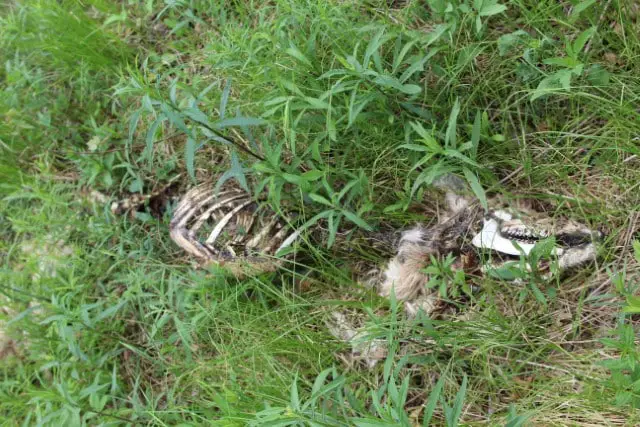
Mammals like deer (and humans) have endoskeletons, meaning the skeletons are found inside the body.
An endoskeleton’s bones are made up of hardened minerals and tissues.
Deer bones serve the same purpose as human bones. A skeleton’s main function is to support the body and protect the vital organs.
Bones are also essential for support. Without a spine, deer wouldn’t be able to walk.
Bones also connect with other components of the deer’s body that are important for movement, like muscles.
Deer Skeleton Anatomy
Although deer have a lot more bones than humans, many of the basics remain the same.
For example, they have a rib cage, a spine, and a skull. The positioning and sizes of these bones are different than in a human skeleton.
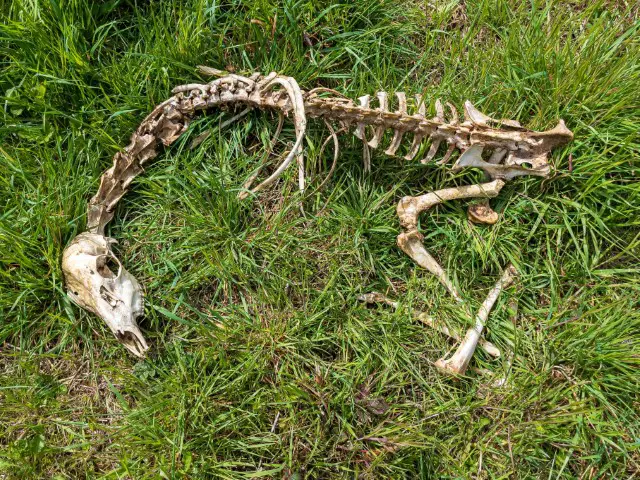
Let’s start at the spine. Human spines are vertically oriented, while deer spines are horizontal. Of course, this impacts the rest of the deer’s anatomy.
The spine provides the skeletal system’s structure. It consists of multiple vertebrae. A tail bone caps it at the bottom, right below the back legs.
The pelvis supports the back legs. It’s also crucial for identifying a deer’s sex.
The front legs are towards the front end of the spine. The scapula supports them.
The scapula, along with the rib cage, protects a deer’s vital organs. This is where a deer’s heart and lungs are located.
The deer’s skull encases and protects its brain. It’s perhaps the most recognizable bone because of the antlers coming out the top.
Antlers are considered bones, as are the deer’s teeth and jaw.
What Do Deer Bones Look Like?
Deer bones look like most animal bones.
They have the same off-white color that you expect from a skeleton, so as long as the bones are clean, they should be easy to recognize as bones.
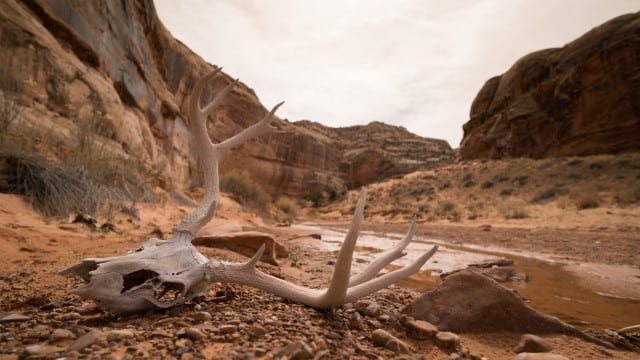
Recognizing them as deer bones as opposed to other types of animal bones can be difficult if you don’t know what to look for.
The obvious clue is the antlers. If you find a deer’s skull or antlers lying around, you can be pretty certain that the bones near it belonged to the same deer.
However, skulls are popular collectors’ items, so it’s not uncommon to find other bones lying around without a skull.
If you find a deer skeleton, the size will probably give it away as belonging to a deer. Of course, deer come in all sizes, so a moose’s skeleton will be much bigger than the skeleton of a white-tailed deer.
An adult deer will also have bigger bones than a young deer.
Other clues that the skeleton belonged to a deer are the pelvis and the feet bones. If you aren’t super familiar with animal anatomy, recognizing the pelvis can be difficult at first.
Deer Bones Identification
Once you’ve identified that the bones you’ve found are deer bones, you’ll probably want to identify what type of deer they belong to.
The first way to figure this out is to know what type of deer inhabit the area you’re exploring. If you live in cold, northern climates, you’re more likely to find elk or moose.
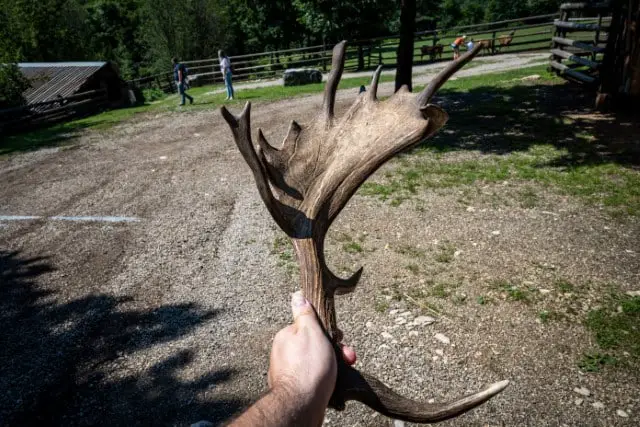
Unless you’re an expert, it’s probably going to be impossible to tell exactly the species of deer by just looking at the bones without a guidebook or some help from a seasoned hunter.
However, you can narrow it down to the basic type and probably identify the sex of the deer.
The pelvis is the main bone that will help you discern between male and female deer. White-tailed deer have a bony growth known as IPE. IPE is short for iliopectineal eminence.
IPE starts growing after about one year, so it won’t be present in deer that are less than a year old. This growth is round or oval-shaped on a buck. It tends to be situated a bit over an inch from the hip socket.
On does, the IPE is next to the hip socket and is flatter than a buck’s growth.
Since the bone growth develops after the deer is a year old and develops differently in males and females, it probably has to do with mating functions.
Old World vs New World Deer
There are hundreds of deer species, and we divide them into two main categories: Old World and New World deer.
Old World deer are part of the Cervinae family. New World deer, on the other hand, are called Capreolinae.
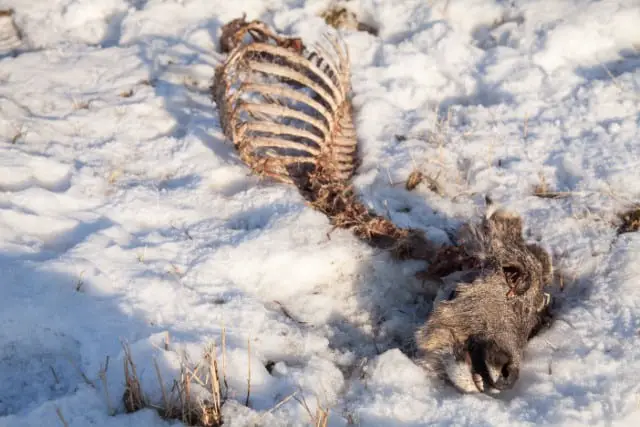
All deer have a common ancestor, and the different names reflect where the deer evolved.
The main difference between Old World and New World deer is in their foot bone structure.
Old World deer have lost two of their toe bones.
In Old World deer, only remnants of two of the foot bones remain. New World deer have retained all of their toe bones.
Within both families, there are further adaptations that are climate-specific.
The main differences between other species of deer are the size, antlers, and fur. From the skeleton alone you won’t be able to tell much about a deer’s fur.
However, if you find the antlers, they can be a pretty big clue as to what kind of deer you’ve found.
Looking at the size of the bones can also help you identify the type of deer. The best way to do this is to try and reassemble the bones into a skeleton so that you can gauge the size of the deer.
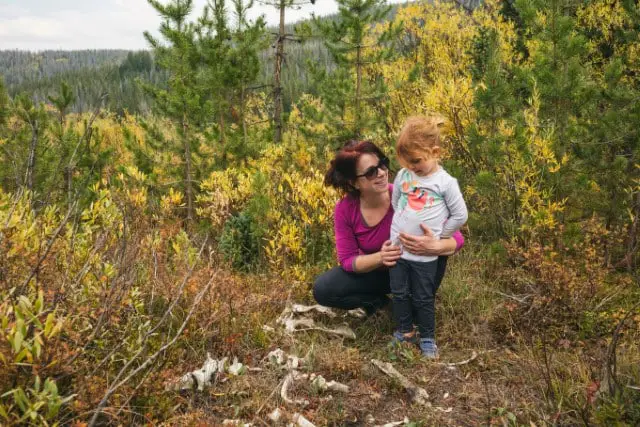
Deer that live in tropical climates have less fur and tend to be smaller than deer living, for example, in Arctic climates. If you only have a deer skeleton, recognizing these differences could be difficult if you don’t have an anatomy textbook handy.
However, if you remember that Old World deer are missing two of their toe bones, you should be able to tell the difference between New and Old World deer.
Are Deer Antlers Bones?
Yes, a deer’s antlers are bones, but they’re unlike any other bones in a deer’s body. While the specifics can vary from species to species, most deer grow and shed their antlers every year.
Antlers are different from horns.
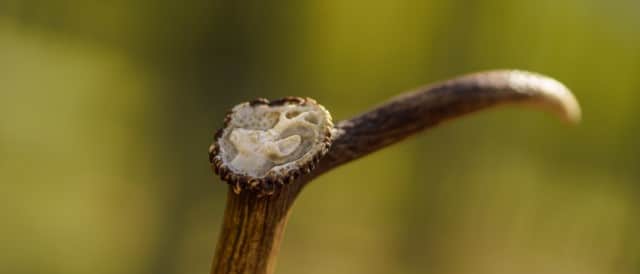
Horns don’t fall off and grow back. Once an animal grows its horns, it keeps them for life.
Deer and other antlered animals lose their horns annually. A deer’s antler cycle revolves around the rutting and mating season.
An antler’s function is to fight other males during the rutting season, which is when male deer compete for female mates. This is why a deer’s antlers are the longest during the rutting season.
Once the rutting season is over, a male deer’s antlers will fall to the ground so that they can grow next season.
So, if you find antlers lying around the forest, it doesn’t mean that a deer has died. It could have just dropped the antlers.
Since deer grow antlers every year, they are some of the fastest-growing bones in the animal kingdom. This makes them of particular interest for medical research.
Some of the other fastest-growing cells on the planet are cancer cells, suggesting that there could be some similarities between deer antlers and cancer cells.
Understanding how and why deer antlers grow so quickly could lead to breakthroughs in cancer research and treatments.
How to Use Deer Bones
Humans have used deer bones for centuries. Here are some ways you can use deer bones.
Decorative Use
In the modern Western world, the primary use of deer bones is decorative.
Just like some people like to mount a buck head on their walls, some people like to hang deer skulls.
However, deer bones, and in particular the antlers, have other uses.
Native tribes in the Americas and Russia use deer antlers as a material for furniture and other household items. In Finland, craftspeople make art and jewelry out of antlers.
Make Tools
You can carve deer bones to create tools. If you want to be very rustic, you could turn the bones into a needle for sewing deer hides.
Other tools you could make with deer bones include knives, fish hooks, and buttons.
Make a Venison Stock
If you’re cooking a venison stew, deer bones are a great ingredient for deer stock. To make the stock, cook the bones down for hours just as you would chicken or beef bones.
Bones are full of nutrients and are a great source of protein, so it’s the best way to get the most nutritious value from the deer.
Use for Fertilizer
Bones have a nutrient content. As a result, you can compost them and use them in your soil fertilizer. It might take a long time, but the bones will eventually break down and decompose in your compost bin (just like they would in the wild).
Burn in the Furnace
Burning bones in the furnace is also another good way to use them. The bones tend to burn longer and hotter than wood, meaning they will keep your house warmer for longer in an environmentally friendly way.
It’s the perfect way to heat up your house after a day of hunting.
Scientific Research
Scientific researchers use deer bones in their studies. As we mentioned earlier, deer antlers are being studied for their potential use in cancer research.
While ordinary bones might not be as unique as antlers, they could also provide scientists with important information that could lead to medical breakthroughs.
Can Dogs Chew On Deer Bones?
If you happen to have a dog and are wondering what to do with your deer bones, you could give the bone to your dog to chew on.
Just make sure you thoroughly clean the bone before giving it to your dog. Fido will end up with a stomach ache if you don’t.
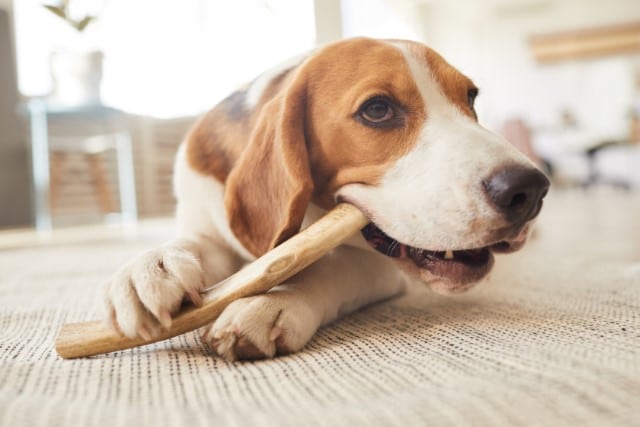
Never cook the bones before giving them to your dog. It’s dangerous.
Cooking the bones softens them up and will make them break or splinter when the dog chews on them.
Don’t give your dog smaller bones. They’re a choking hazard.
Bigger, sturdier bones are the ones you want to let your dog play with.
Other Ways to Use Deer Remains
Eating meat (venison) is the most obvious way a deer can be used.
Venison meat is great for steaks and stews. Other parts of the deer can be ground up to make burgers.
Deer innards can be processed for sausages.
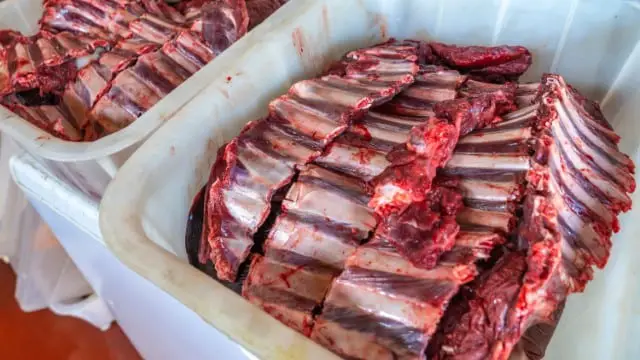
Even the blood can be used to make a traditional blood sausage. If you don’t have the equipment to do this yourself, you can sell it to a local butcher.
Deer hides are a popular material for leather. If you have the time and the resources, you can process deer hides in your backyard to make your own coats, blankets, or custom bags.
Rawhide that hasn’t been tanned can be used as strips for raw leather or chewing straps for your dog.
Final Thoughts: Deer Bones and Skeletal System
There are many similarities between human and deer bones. In both animals, the functions of bones are support, protection, and movement.
Despite the similarities, there are plenty of important differences between human and deer bones. These include the fact that a deer’s anatomy is primarily horizontal as opposed to vertical, and deer often have antlers.
A deer’s antlers are another type of bone and are a fascinating piece of deer anatomy. Understanding antlers and deer bones could be key for medical breakthroughs.
Knowing how to locate a deer’s bones is essential for hunters who are looking to make a clean kill.

